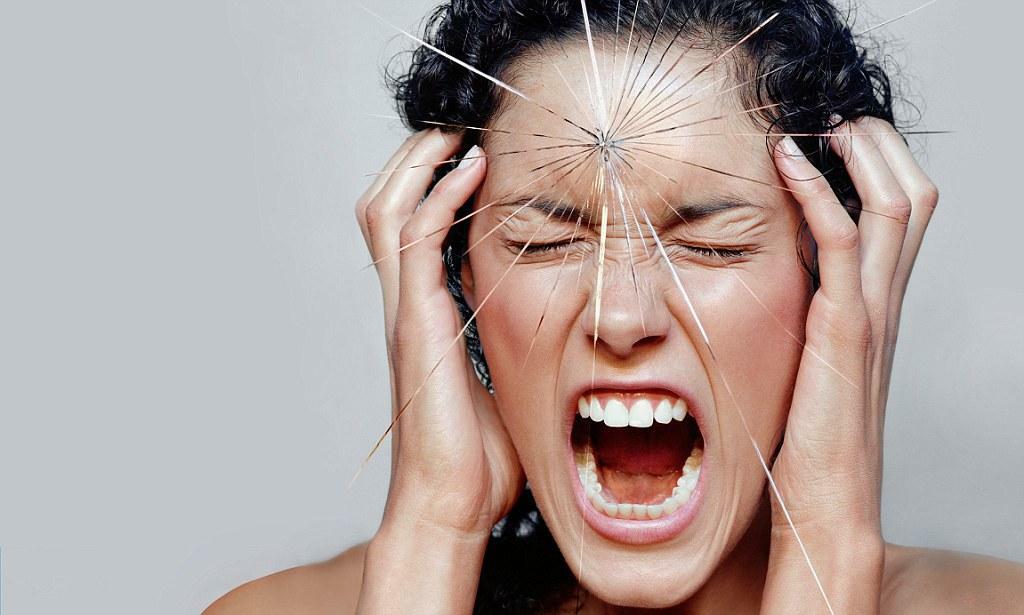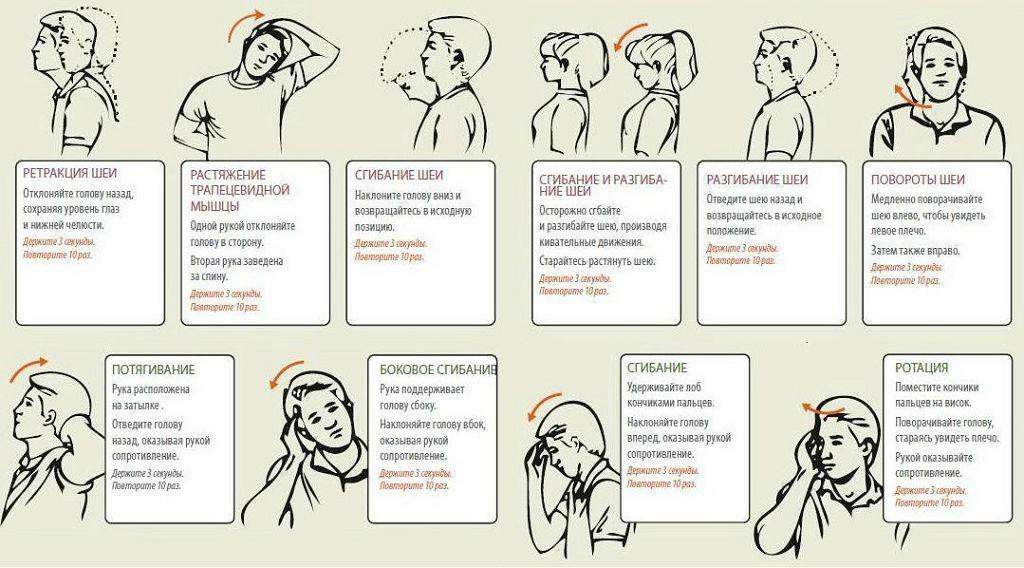Disease of the spine doctors often call a person's payment for the upright, but in our time this problem can be considered as a punishment for the wrong way of life and work at the computer. One of the most common diseases to date is osteochondrosis, in particular, the one that develops in the cervical spine. What is this problem, how to distinguish it from other types of ailment and how can we get rid of it?

Cervical osteochondrosis: symptoms, treatment, injections
Content of the material
- 1 What is osteochondrosis of the cervical region?
- 2 Why does cervical osteochondrosis develop?
- 3 Symptoms of cervical osteochondrosis
- 4 What is dangerous cervical osteochondrosis?
- 5 diagnosis of degenerative disc disease of the cervical spine
- 6 treatment of cervical degenerative disc disease
- 6.1 Videos - Cervical osteochondrosis - symptoms, treatment and exercise
- 7 Traditional treatments
- 7.1 Medications
- 7.2 Intramuscular injections
- 7.3 physiotherapy
- 8 Alternative treatment
- 8.1 Traditional recipes
- 8.2 Video - Treatment of osteochondrosis of the cervical spine folk remedies
- 8.3 Alternative therapy
- 9 Prevention wosteochondrosis
What is cervical osteochondrosis?
The cervical spinal column consists of seven vertebrae, and represents the most mobile part of it - it provides turns and inclinations of the head and has weak muscles. All these features are the reason that this area is most often subjected to injuries and degenerative changes, which is osteochondrosis. Each of the disks of the spine consists of a fibrous ring, in the center of which is a nucleus of pulpous tissue.
If the load on the spinal column is disturbed, the integrity of the ring is broken, they can bulge and flatten out, which leads to unpleasant symptoms and consequences.
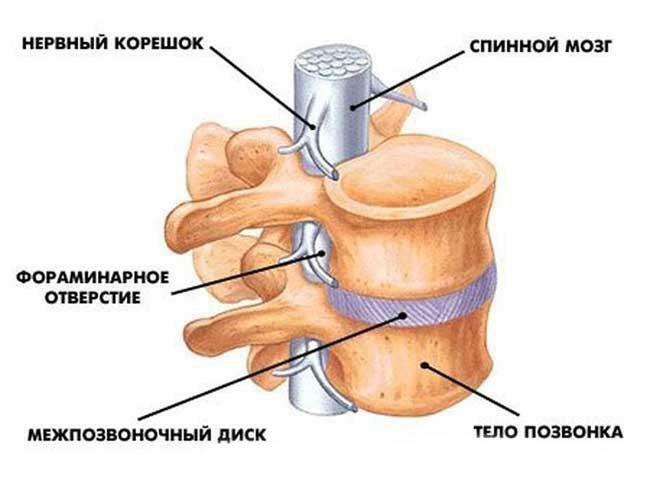
The structure of the vertebra
Why does cervical osteochondrosis develop?
The causes of osteochondrosis of the cervical spine are the same as those of the other varieties of this disease.
- Hypodinamia of ( lack of physical activity).Most often, cervical osteochondrosis develops in people who, by their activity, have to sit for a long time in a sitting position. These are office workers, schoolchildren and all those who often work at the computer( that is, the overwhelming majority of modern people).The risk of developing osteochondrosis aggravates the habit of sitting in a bent position or stooping.
- Concomitant diseases. The organism of any person is a unified system, therefore some diseases( kidneys, gastrointestinal tract), disorders related to metabolism, negatively affect the health of the spine. For example, if the urinary system is not functioning properly, a large number of salts are deposited in the spine and, in particular, in the cervical region, which leads to the development of osteochondrosis.
- Poor nutrition. The organism of any person is a unified system, so an inadequate diet with insufficient amounts of microelements and vitamins can lead to deterioration of the body tissues, including bone, fibrous, etc. Excess weight. Extra pounds, which appear due to malnutrition or metabolic disorders, leads to increased stress on the spine, which causes the discs to gradually break down.
- Frequent injury, shock and other mechanical effects. The negative impact of this plan is regularly met by drivers, professional athletes and people who are engaged in heavy physical labor. In addition, osteochondrosis can develop due to car accidents and serious spinal injuries in the past.

Damage to vertebrae in osteochondrosis
Risk factors for the development of the disease include heredity, smoking, improper physical training, hypothermia and decreased immunity.
Symptoms of cervical osteochondrosis
The process of development of degenerative changes in the spine is absolutely painless, and does not cause any discomfort to a person. When the vertebral discs are seriously deformed, the patient begins to show symptoms that eventually grow and can lead to very serious consequences.
- The crunch. The first sign of osteochondrosis, which manifests itself in the early stages, is a crunch that is heard when you turn and tilt your head. Usually they do not pay attention to this phenomenon, since it does not cause any discomfort. In fact, a crunch is a serious reason to consult a doctor, as eliminating the disease at this stage is quite simple.
- Pain. Pain syndrome is one of the key symptoms of the disease that occurs after defects and degenerative changes develop in vertebral discs. Patients may be concerned about pain of a different nature - sharp, sharp "lumbago" or burning pain in the neck that occurs after movements or a long static position. Later, when the disease begins to progress and there is an infringement of the spinal roots, other symptoms join the pain syndrome, which depend on which particular part of the spine has suffered.

Scheme of the cervical spine
Designation of the intervertebral disc Symptoms
C1 Numbness and discomfort in the nape
C2 Pain in the region of the head and occiput
C3 Reduces the sensitivity of the skin in the part of the neck where the damaged root is. Possible loss of control over the speech device
C4 Pain and discomfort in the shoulder and shoulder area, hypotension of the neck muscles, sometimes there are breathing disorders, pain in the heart and liver
C5 Unpleasant sensations and pain in the anterior surface of the shoulder
C6 Pain syndrome,which extends from the neck to the shoulder blade, the forearm, the outer side of the shoulder towards the thumb
C7 Pain, numbness and other unpleasant sensations that extend from the neck towards the scapula, the posterior oneONET shoulder and forearm to the index and ring fingers
C8 pain and discomfort, which originate in the neck and extend towards the little finger
- remaining symptoms. The signs that are noted in patients diagnosed with osteochondrosis include:
- stiffness of movements of the shoulder girdle and hands;
- pathological tension of the neck muscles;
- nausea, vomiting;
- vision impairment( "flies" before the eyes, darkening, disruption of focus);
- periodic increases in blood pressure;
- pain or sensation of a coma in the throat;
- toothache, deterioration of teeth;
- sleep disorders( insomnia, drowsiness);
- dizziness, which can lead to unconsciousness;
- violation of coordination of movements, in particular, gait;
- tinnitus, hearing impairment;
- changes in voice( hoarseness, hoarseness);
- disturbances of a psycho-emotional background( tearfulness, irritability).
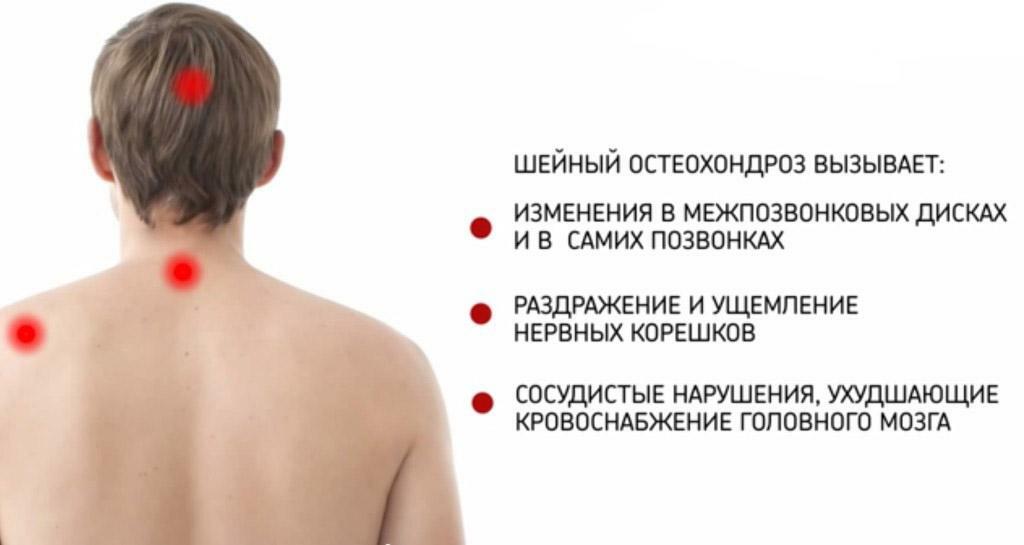
Cervical osteochondrosis leads to disorders of the body
It should be noted that it is quite difficult to diagnose osteochondrosis at this stage, as its symptoms are diverse, and may be similar to the signs of intercostal neuralgia, hypertension, cardiovascular disorders.
What is dangerous cervical osteochondrosis?
Cervical osteochondrosis is one of the most dangerous types of disease. Through this part of the spine there is a large number of blood vessels and nerve channels that feed the brain, so any violations can lead to serious consequences. Constant infringement of the nerve roots also causes serious violations in the body, up to a partial loss of mobility and disability.
Violation of cerebral circulation leads to the development of migraines, vegetovascular dystonia, hypertensive disease, and in neglected form it can cause a syndrome of the vertebral artery. This is a large artery that supplies blood to the cerebellum and medulla oblongata, therefore, as a result of its lesions, the patients develop ischemia of the brain and spinal cord, as well as spinal stroke. The most severe consequence of osteochondrosis, which can develop as a result of the defeat of the cervical spine, is compression of the spinal cord, as a result of which a fatal outcome may occur.
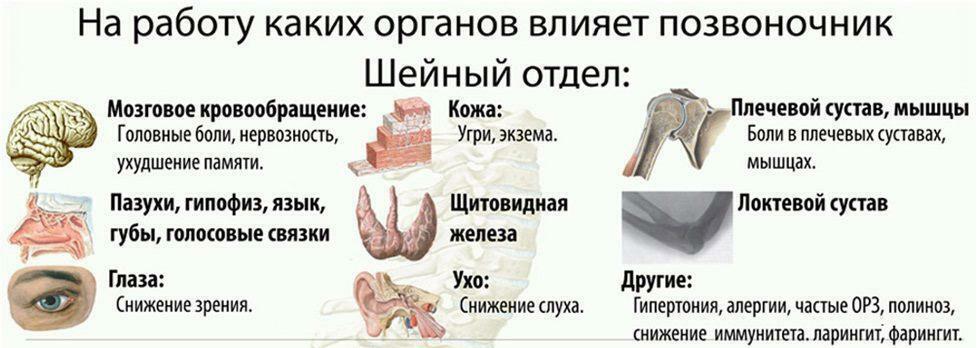
Organs responsible for the cervical department
Diagnosis of cervical osteochondrosis
If symptoms of the disease, especially pain and crunch in the neck, you should immediately contact a specialist in neurology and orthopedics. With the help of physiological tests, the specialist will assess mobility, sensitivity and soreness in the cervical spine area, and also check other functions. After this, X-ray of the affected area in several projections, and if necessary - CT and MRI, to exclude hernia and neoplasm of the spine.
Treatment of cervical osteochondrosis
In the treatment of cervical osteochondrosis, traditional and alternative methods can be used, but in any case, treatment should be comprehensive and carried out in several stages. Traditional methods include medications that eliminate the main symptoms of the disease, as well as physiotherapy procedures, and in rare cases - surgical intervention.
Video - Cervical osteochondrosis - symptoms, treatment and exercises
Traditional methods of treatment
Medications
In osteochondrosis of the cervical part, a number of preparations are used, including means for oral and external use.
- Analgesics. Reception analgesics( "Analgin", "Ketorol", "Tempalgin") well relieves pain.
- Non-steroidal anti-inflammatory drugs. Among such means are "Diclofenac", "Ibuprofen", "Movalis".It is important to note that any tablets that are taken with cervical osteochondrosis affect the gastrointestinal tract in one way or another, therefore it is necessary to resort to their help only in extreme cases.
- Chondroprotectors. The use of drugs of this series( Teraflek, Alflutop, Arthra), which are designed to prevent and slow down the destruction of cartilaginous tissue, is a contentious issue. Some doctors consider them to be effective against cervical osteochondrosis, while others are classified as dietary supplements and say that they do not bring any benefit.
- Spasmolytics and muscle relaxants."No-shpa", "Midokalm" and other similar remedies well eliminates the muscular spasm arising during osteochondrosis.
- Ointments for external use. To reduce the intensity of the pain syndrome, you can use warming and irritating agents( "Apizarthron", "Finalgon").Help and warming plasters are also helpful - they are glued to the area where the pain is felt, and they are worn all day. Unlike other drugs, they have an exclusively local effect and do not cause such harm to the body as analgesics or anti-inflammatory drugs.

Finalgin Ointment for treatment of cervical osteochondrosis
Intramuscular injections of
Intramuscular injections, that is injections are considered to be one of the most effective means for controlling cervical osteochondrosis, as they quickly reach the affected area and give the desired effect.
Pain syndrome in this disease is well eliminated so-called Novocain blockades - they consist in the fact that the affected area is cheated with novocaine. This method quickly and permanently relieves patients of pain, but can not be considered a full-fledged therapeutic agent, as it only alleviates the symptoms. In addition, for these purposes, analgesics and non-steroidal anti-inflammatory drugs are administered in the form of injections.
- Analgesics for pain relief: "Analgin", "Baralgin".
- Muscle relaxants: the most effective drug is "Midokalm".
- Non-steroidal anti-inflammatory drugs: Ketorolac, Ibuprofen, Diclofenac.
- Glucocorticosteroids: "Diprospan", a complex preparation "Ambene".
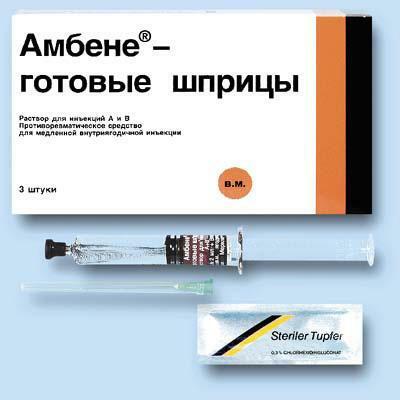
Ready syringes Ambene for pain relief in case of osteochondrosis of the cervical spine
It is important to note that it is necessary to treat osteochondrosis with anesthetizing injections with great care. The fact is that the pain in this disease is some indication that the patient should not make any sudden movements, that is, its absence, however strange it may sound, can lead to serious complications.
A much better effect in terms of fighting the symptoms of the disease gives a course of vitamin therapy. B vitamins contribute to the rapid restoration of the normal state of the nerve roots, and vitamin PP improves the blood supply to the affected area.
Physiotherapy
Physiotherapeutic procedures are a necessary part of the complex therapy of cervical osteochondrosis. They eliminate pain syndrome, relieve muscle spasms, improve blood circulation and metabolism in affected tissues. These include electrophoresis, UHF, magnetotherapy, water procedures, paraffin applications. A good effect is provided by a collar zone massage, either conventional or spot.
Sometimes doctors recommend that patients wear the collar of Shantz - a flexible device that is fixed around the neck to redistribute the load and relieve pain. It should be noted that it is not recommended to constantly wear such a collar, otherwise the neck muscles will be greatly weakened.
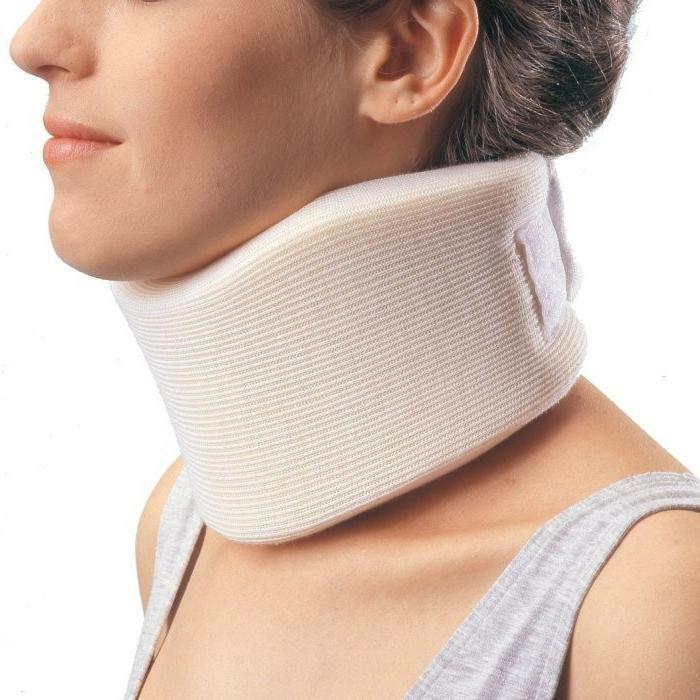
Shantz collar for the redistribution of the load in osteochondrosis
During rehabilitation after passing the therapeutic course, the patient is shown therapeutic physical activity and easy physical activity.
Nontraditional therapies
Folk recipes
Traditional medicine recipes that are used to treat cervical osteochondrosis are primarily compresses and mixtures for grinding. They all have a warming effect, and act just like ointments and patches. Means are prepared from melted butter, garlic, radish, honey, and as packs of horseradish, dry mustard, turpentine.
Video - Treatment of osteochondrosis of the cervical spine with folk remedies
Alternative therapy
As the methods of alternative therapy, the patients are prescribed the following procedures:
- reflexotherapy;
- chiropractic;
- treatment with medical leeches;
- treatment using live bees and bee venom;
- osteopathy.
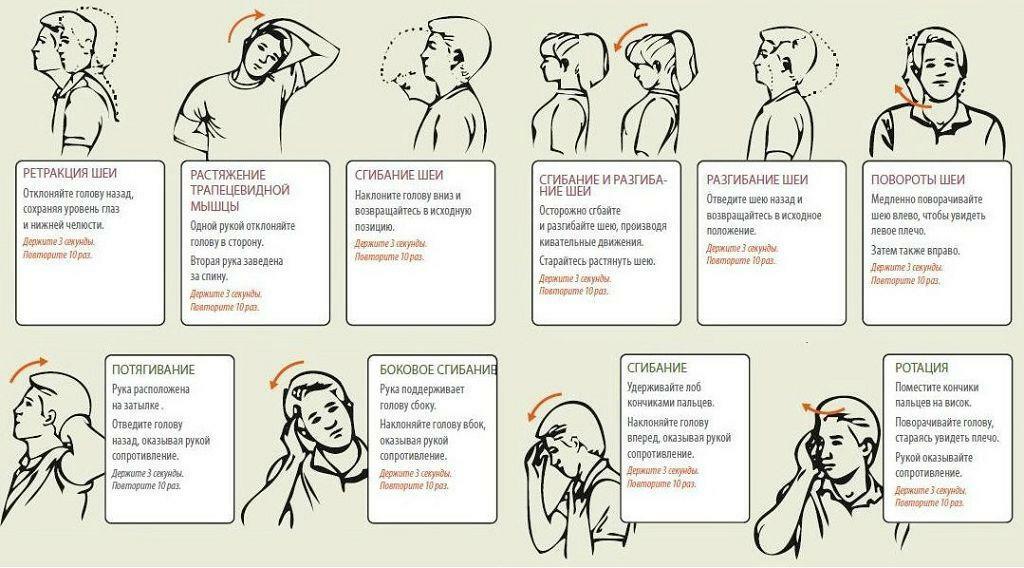
Gymnastics for osteochondrosis
Similar methods of treating osteochondrosis are questioned by traditional medicine doctors, but are not considered banned. The only condition is that specialists on alternative methods should be sufficiently experienced, otherwise the harm from treatment will be much more than good.
Prevention of cervical osteochondrosis
Like any other health problem, cervical osteochondrosis is much easier to prevent than cure. To do this, you need to sleep properly on an orthopedic mattress and pillow, exercise, walk more, eat right. Especially these recommendations are important to people who are at risk: they do sedentary work or have a genetic tendency to osteochondrosis.

